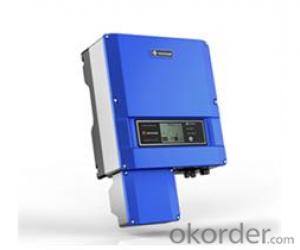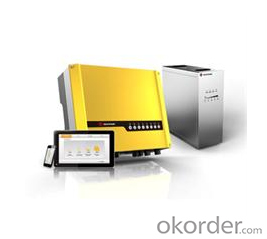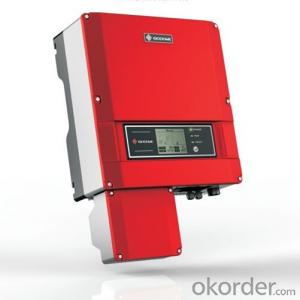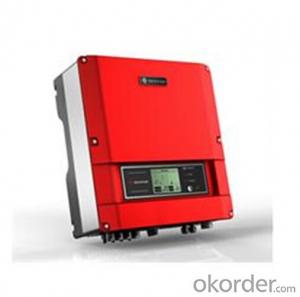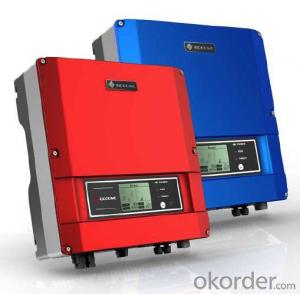High Frequency Isolated Solar Inverter Charger GW3000/3600/4200D-DI
- Loading Port:
- Shanghai
- Payment Terms:
- TT OR LC
- Min Order Qty:
- 10 unit
- Supply Capability:
- 100 unit/month
OKorder Service Pledge
OKorder Financial Service
You Might Also Like
GW3000/3600/4200D-DI (High Frequency Isolated)
GoodWe DI series inverter is the new on-grid PV inverter which integrated with most advanced technology, come with 10 years warranty, and are designed to meet the new IEE1547 requirements for the North American market. Also it’s suitable for thick-film modules. Easy installation and simple operation make them ideal for residential and small-to-medium commercial applications. GoodWe inverters, with ever-increasing efficiency and high stability, could ensure you better overall performance of solar power systems and shorter payback periods.
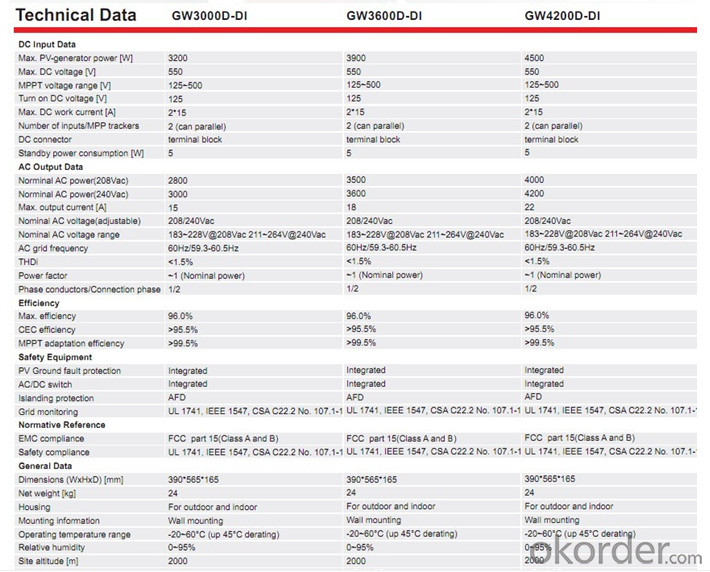
- Q: What is the role of a display interface in a solar inverter?
- The role of a display interface in a solar inverter is to provide real-time information and control options to the user. It allows the user to monitor the performance of the solar inverter, such as its power output, voltage levels, and error status. The display interface also enables the user to adjust settings, configure parameters, and troubleshoot any issues that may arise. Overall, it serves as a user-friendly tool for managing and optimizing the operation of the solar inverter system.
- Q: Can a solar inverter be used in commercial or industrial applications?
- Yes, a solar inverter can be used in commercial or industrial applications. Solar inverters are designed to convert the direct current (DC) generated by solar panels into alternating current (AC) suitable for use in commercial or industrial settings. They are commonly used to power various electrical loads, machinery, and equipment in these sectors, helping to reduce energy costs and promote sustainability.
- Q: What is the difference between an on-grid and off-grid solar inverter?
- The main difference between an on-grid and off-grid solar inverter lies in their functionality and purpose. An on-grid solar inverter is designed to convert the direct current (DC) electricity generated by solar panels into alternating current (AC) electricity that can be fed into the electrical grid. This type of inverter is used in grid-tied solar systems, where excess energy can be sold back to the utility company, allowing homeowners to benefit financially. On the other hand, an off-grid solar inverter is used in standalone solar systems that are not connected to the electrical grid. It is responsible for converting the DC electricity produced by solar panels into AC electricity suitable for powering off-grid appliances and storing energy in batteries. Off-grid inverters often include additional features like battery charging and management to ensure reliable power supply in the absence of grid connection. In summary, while both on-grid and off-grid solar inverters convert DC to AC electricity, their purposes differ significantly. On-grid inverters enable homeowners to utilize the grid as a power storage and distribution system, while off-grid inverters are essential for self-sustaining solar systems that operate independently of the grid.
- Q: What is the role of a solar inverter in grid management and stability?
- The role of a solar inverter in grid management and stability is crucial in integrating solar power into the existing electrical grid system. Solar inverters are responsible for converting the direct current (DC) electricity generated by solar panels into alternating current (AC) electricity that can be used by homes and businesses or fed back into the grid. In terms of grid management, solar inverters play a vital role in maintaining the stability and reliability of the electrical grid. They provide grid support functions such as voltage regulation, frequency control, and reactive power compensation. By monitoring the grid conditions and adjusting the output of solar power accordingly, inverters help to balance the supply and demand of electricity in real-time, ensuring grid stability. Solar inverters also contribute to grid stability by improving power quality. They actively filter out harmonics, voltage fluctuations, and other electrical disturbances that can be caused by the intermittent nature of solar power generation. This ensures that the electricity generated by solar panels is of high quality and does not introduce any disruptions or damage to the electrical grid. Furthermore, solar inverters enable the seamless integration of solar power into the grid, allowing excess energy to be fed back into the system. This is known as net metering or feed-in tariff programs, where solar energy producers can receive compensation for the surplus electricity they produce. With the help of inverters, the generated solar energy can be efficiently transferred to the grid, reducing the reliance on traditional fossil fuel-based power generation and promoting renewable energy integration. Overall, the role of a solar inverter in grid management and stability is to ensure the smooth integration and optimal utilization of solar power, while maintaining the stability, reliability, and quality of the electrical grid. It acts as a bridge between solar energy producers and the grid, facilitating the efficient and sustainable integration of renewable energy sources into the existing power infrastructure.
- Q: Can a solar inverter be used with solar-powered water heaters?
- No, a solar inverter cannot be directly used with solar-powered water heaters. The solar inverter is designed to convert the DC power generated by solar panels into AC power for general electrical use in households. On the other hand, solar-powered water heaters utilize direct thermal energy from the sun to heat water, without involving the need for converting DC power to AC power.
- Q: Are there any disadvantages of using a solar inverter?
- Yes, there are a few disadvantages of using a solar inverter. Firstly, solar inverters are sensitive to extreme temperature variations, and their efficiency can be affected in very high or low temperature conditions. Secondly, solar inverters require regular maintenance and occasional replacement, which adds to the overall cost of the system. Additionally, solar inverters produce a small amount of electromagnetic interference (EMI) which can interfere with nearby electronic devices if not properly shielded. Lastly, solar inverters are grid-tied systems, meaning they rely on a stable electrical grid to function. In case of power outages or grid malfunctions, solar inverters may shut down and stop supplying power to the connected devices.
- Q: Are there any limitations on the angle of the solar panels when using a solar inverter?
- Yes, there are limitations on the angle of the solar panels when using a solar inverter. The angle at which solar panels are installed can affect their efficiency and overall performance. Ideally, solar panels should be installed at an angle that allows them to receive maximum sunlight throughout the day. Most solar panels are designed to work optimally when installed at an angle that is equal to the latitude of the location. This angle allows the panels to capture the most sunlight during peak hours. However, this is not a strict rule and variations are possible depending on the specific location and climate conditions. If solar panels are installed at an angle that is too steep or too shallow, it can result in reduced energy production. Steep angles may cause the panels to lose sunlight during certain times of the day, while shallow angles may not allow for optimal sunlight absorption. Additionally, extreme angles can also increase the risk of damage from wind or other weather conditions. It is important to note that modern solar inverters often come with advanced tracking and monitoring technologies that can adapt to different panel angles and orientations. These features can optimize energy production by adjusting the inverter settings based on the real-time performance of the panels. Overall, while there are limitations on the angle of the solar panels, it is crucial to ensure that they are installed in a way that maximizes their exposure to sunlight throughout the day to achieve the highest energy production possible.
- Q: How does a solar inverter handle reactive power injection into the grid?
- A solar inverter handles reactive power injection into the grid by using advanced control algorithms and capacitors. It actively monitors the grid's voltage and frequency and adjusts its output to maintain the required power factor. The inverter can either absorb or inject reactive power into the grid as needed to ensure a stable and balanced power flow.
- Q: Can a solar inverter be used with concentrated photovoltaic systems?
- Yes, a solar inverter can be used with concentrated photovoltaic systems. A solar inverter is responsible for converting the direct current (DC) electricity generated by the photovoltaic panels into alternating current (AC) electricity that can be used to power electrical devices. This conversion process remains the same regardless of the type of photovoltaic system being used, including concentrated photovoltaic systems. Therefore, a solar inverter is an essential component for converting the DC electricity produced by concentrated photovoltaic systems into usable AC electricity.
- Q: What is the role of a solar inverter in a solar-powered desalination system?
- The role of a solar inverter in a solar-powered desalination system is to convert the direct current (DC) electricity generated by the solar panels into alternating current (AC) electricity that can be used to power the desalination equipment. The inverter ensures efficient and safe power conversion, allowing the system to effectively utilize the energy generated by the solar panels for the desalination process.
Send your message to us
High Frequency Isolated Solar Inverter Charger GW3000/3600/4200D-DI
- Loading Port:
- Shanghai
- Payment Terms:
- TT OR LC
- Min Order Qty:
- 10 unit
- Supply Capability:
- 100 unit/month
OKorder Service Pledge
OKorder Financial Service
Similar products
Hot products
Hot Searches
Related keywords
